- Joined
- May 25, 2020
- Messages
- 1,053
- Points
- 443

Pete! Understood.Tx. Chuck. Got a full plate. Don't know when I'll get back to the shipyard.

Blessings.
Chuck
 |
As a way to introduce our brass coins to the community, we will raffle off a free coin during the month of August. Follow link ABOVE for instructions for entering. |
 |

Pete! Understood.Tx. Chuck. Got a full plate. Don't know when I'll get back to the shipyard.



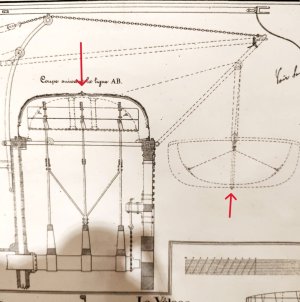

 ). These ripples were there, perhaps not quite so prononuced, when I took the bateaux off the buck. They really showed up after I gave the hull a coat of matte medium and painted. These ripples are not present on the shorter versions. I think this may have something to do with the length, but probably more to do with the number of strakes and the amount of overlap of the strakes. I also noted a tendency for the sides to want to curve inboard. I hope the decking and bulwarks at both ends will help with this issue. I foresee spending a few hours making a couple more bateaux-tambour, you know, just in case.
). These ripples were there, perhaps not quite so prononuced, when I took the bateaux off the buck. They really showed up after I gave the hull a coat of matte medium and painted. These ripples are not present on the shorter versions. I think this may have something to do with the length, but probably more to do with the number of strakes and the amount of overlap of the strakes. I also noted a tendency for the sides to want to curve inboard. I hope the decking and bulwarks at both ends will help with this issue. I foresee spending a few hours making a couple more bateaux-tambour, you know, just in case.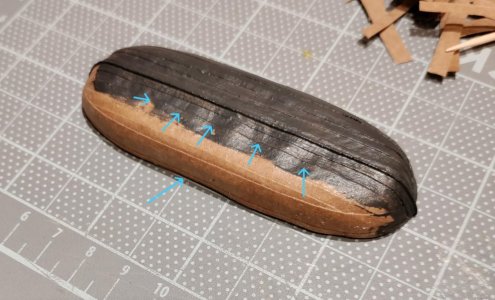


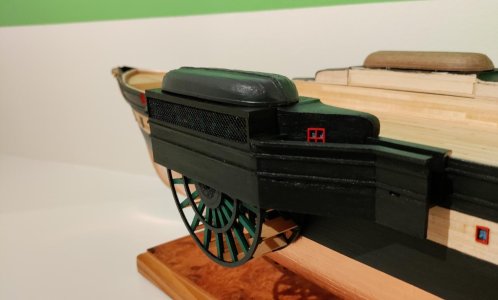
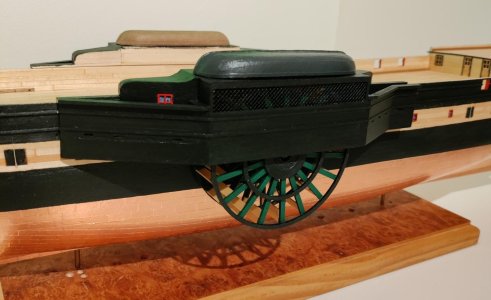
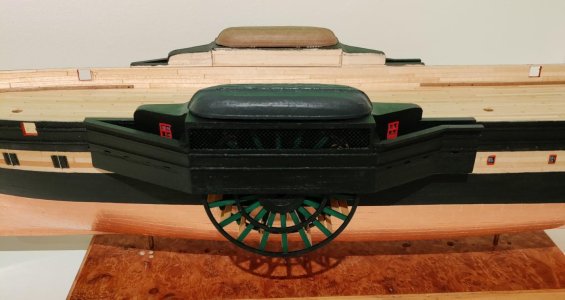

Martin! Thinking about this post last night, I looked at the kit plans - which I haven't done for a couple of months. Too right, my friend! The kit plan shows the foremast much taller than the main. So many inaccuraciesone more yack and then i'll leave you to it.... i knew something was bugging me and now it's clicked ! I just can't see the foremast being higher than the mainmast as in mamoli style. if you look at the new york sail plan it shows standard proportions and i think that is much more likely. Sorry for the rant !


Jeff! I should have had a V8! Yes, your suggestion makes sense of the absent rudder. But it's a row boat 34'5" long weighing 5300+ lbs. I imagine that it would be hard to steer like a row boat. Also there's a step for a mast. Probably my lack of knowledge and lived experience that explains my hesitation about the absent rudder.If they use it like a row boat, they can steer it using asymetrical use of the side oars, like you would in a small rowboat.

Perhaps the rudder was shipped (removed) for storage, and mounted when the boat was deployed.Jeff! I should have had a V8! Yes, your suggestion makes sense of the absent rudder. But it's a row boat 34'5" long weighing 5300+ lbs. I imagine that it would be hard to steer like a row boat. Also there's a step for a mast. Probably my lack of knowledge and lived experience that explains my hesitation about the absent rudder.
Blessings.
Chuck
Concur with Peter. Using spray paint or an air brush should also minimize that effect as the paint is applied with much less solvent soaking into the paper. Another option might be painting the paper before assembling the boat.I think the ripple effect on your boats comes from using water-based paint over paper. Perhaps it will even out given time, or even a little boost in drying with a very careful application of warm air from a hair dryer. At any rate I think the ripple will settle down given time as the paint cures. The acrylic has to cure as the water content is slowly released. I think the problem will exist whatever the paint vehicle. Probably to a lesser degree for a solvent-based paint.

I'll be watching with keen interest.What ho, shipmates!
Well, spring break is almost over. My Admiral returns tomorrow. Shangri-la is squared away by the lifts and braces and I'll probably complete my Harriet Lane build this weekend.
So. What's next? Well. It's in the title of the log.I don't know what to say other than I need to build another sidewheeler. So, shipmates, while I await my package from @Model Shipways (thanks for carrot-and-sticking me into buying this kit 40% off and TARRIFS ARE COMING!
) I thought I'd get started recruiting your expertise in particular because the model turns out to be "fanciful" relative to the actual class of French sidewheel ships from the late 1830's.
I did, however, learn from my Harriet Lane build - the internet is vast and full of stuff like ships plans for free! So, I found a French SoS via a British SoS and with the help of Google translate found plans for L'Orenoque and a basic deck plan for one of her bigger sisters (I think) Le Descartes. Sorry for the image quality. The conversion from tif to jpeg is not optimal.
So, shipmates, please consider this my humble request for all of your sources for plans, translations, images, color post cards, books, etc.
Blessings. Peace. Gratitude.
Chuck
View attachment 510263
View attachment 510265View attachment 510266

Pete! I agree with you in principle.I think the ripple effect on your boats comes from using water-based paint over paper. Perhaps it will even out given time, or even a little boost in drying with a very careful application of warm air from a hair dryer. At any rate I think the ripple will settle down given time as the paint cures. The acrylic has to cure as the water content is slowly released. I think the problem will exist whatever the paint vehicle. Probably to a lesser degree for a solvent-based paint.
 There was significant rippling before the paint job. I notice the issue when I took the prototype off the buck. I was also thinking that using enamel might be the way to go. We'll see . . .
There was significant rippling before the paint job. I notice the issue when I took the prototype off the buck. I was also thinking that using enamel might be the way to go. We'll see . . . 
Perhaps the rudder was shipped (removed) for storage, and mounted when the boat was deployed.
Namabiiru! I think so too. I just find it strange that the gudgeons are absent from the detail of the original plans. I'll probably add a rudder to the bateaux-tambour that will be rigged out for lowering. I'll see what I can do to indicate gudgeons on the one that will be shown stowed.Concur with Peter. Using spray paint or an air brush should also minimize that effect as the paint is applied with much less solvent soaking into the paper. Another option might be painting the paper before assembling the boat.


Ted! Thank you for checking out my log! I hope you are well and wish you success on your ZHL San Felipe 1690 build!I'll be watching with keen interest.
Enjoy your new project


Roger! Excellent! Thank you! I really like your thinking. Very bouyant but really heavy monsters stowed upsidedown. Hard to get into the water. So there needs to be a really good reason to go to the effort of turning them rightside up lowering them recovering them and turning them back upside down. A really good reason like recovering anchors, major vitualing operations or coaling. Plus there are five other ships's boats on davits easily lowered and recovered for the regular work of a warship.Chuck, I wonder if these are intended to be used as barges, ie. towed by other boats. The massive windlass shown on the drawing would indicate that they were used to lift anchors and the shape of the hull would provide plenty of flotation. As a European designed vessel, I would assume that she was intended to burn coal not wood. In the absence of developed coaling facilities these tambour bateaux could be used to haul coal to her while she was moored in the harbor.
Roger


Actually I'm in the emergency room again while I read this,but all is going to be alrightTed! Thank you for checking out my log! I hope you are well and wish you success on your ZHL San Felipe 1690 build!
Blessings. Peace. Gratitude.
Chuck

Maybe sealing the paper boats with clear acrylic spray matte or pastel sealer will help prevent or minimize the absorption of water from acrylic. Also, the acrylics formulated for plastic modelers may not penetrate as deeply into the paper, they use a more alcohol like thinner.Namabiiru! I think so too. I just find it strange that the gudgeons are absent from the detail of the original plans. I'll probably add a rudder to the bateaux-tambour that will be rigged out for lowering. I'll see what I can do to indicate gudgeons on the one that will be shown stowed.
As to the rippling - I put acrylic matte medium down as a base and painted over that. Maybe the mistake was the acrylic matte medium? That porous grocery bag paper needs some kind of primer - right? Otherwise all it will do is soak up more and more liquid. I'll keep working at it - not including investing in an airbrush!
Good news is that I have plenty of stock to make the planks and I'm getting better and faster at producing the bateaux - So, if you're out there trying to turn your French steam frigate of 450 hp into something like the historical ship please feel free to place your order. The price will be determined by fluctuations in my emotional state.
Seriously - I think the number of strakes and the amount of overlap is the solution. The rippling is only present on the prototype - the one with the fewest strakes and the least amout of overlap. The grocery bag paper soaks up Titebond like a sponge. Based on the behavior of my second and third bateaux, I believe that absoption process and the additional overlap leaves much less "open" sponge to soak up the matte medium and the paint.
Add a little more patience, don't slather on the matte medium or the paint, release the blow-dryer on low heat at the right distance and the chances of successfully avoiding ripples increases dramatically! I believe.
Blessings.
Chuck

I used Varenacline tartate to quit. It blocks the nicotine uptake nodes making you feel like you just finished smoking a cigarette. Then you just have to deal with habit of smoking.Congratulations! Well done!
(Now after that astounding display of grit, determination, Stamina and will power, would you, for all our sakes [not to mention your beloved wife and loved ones] please quit smoking?
Pete
I hope you recover quickly !Actually I'm in the emergency room again while I read this,but all is going to be alright
